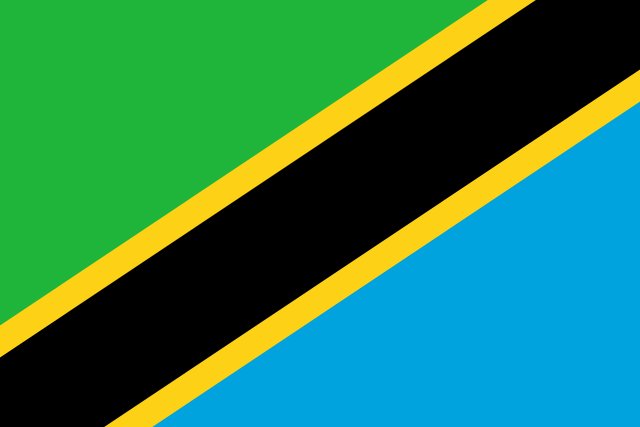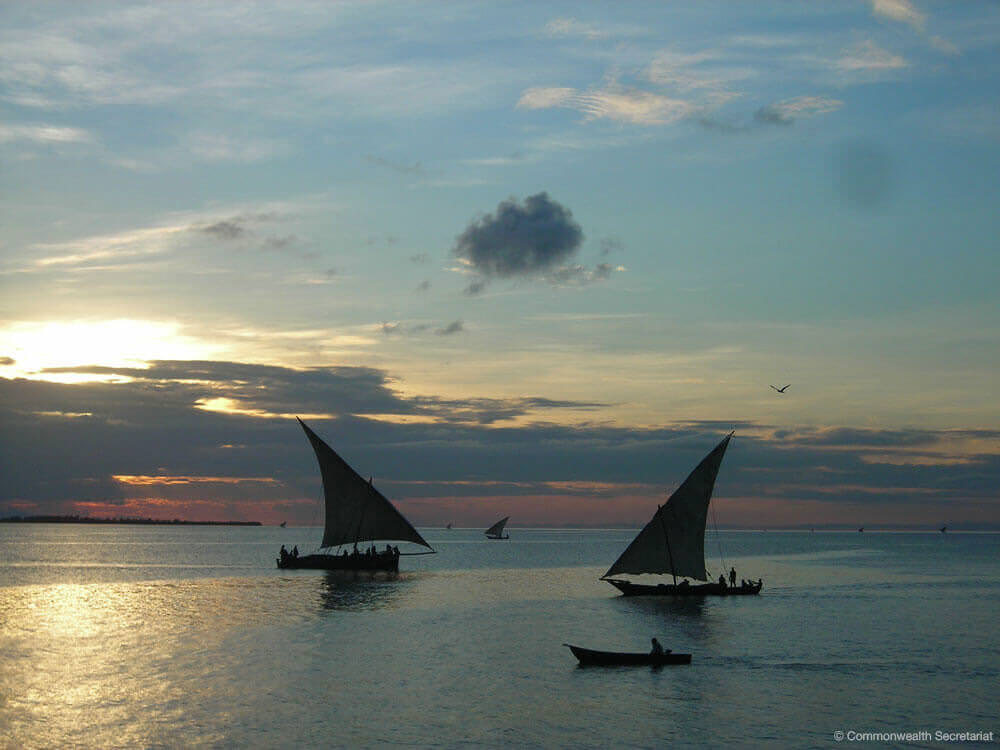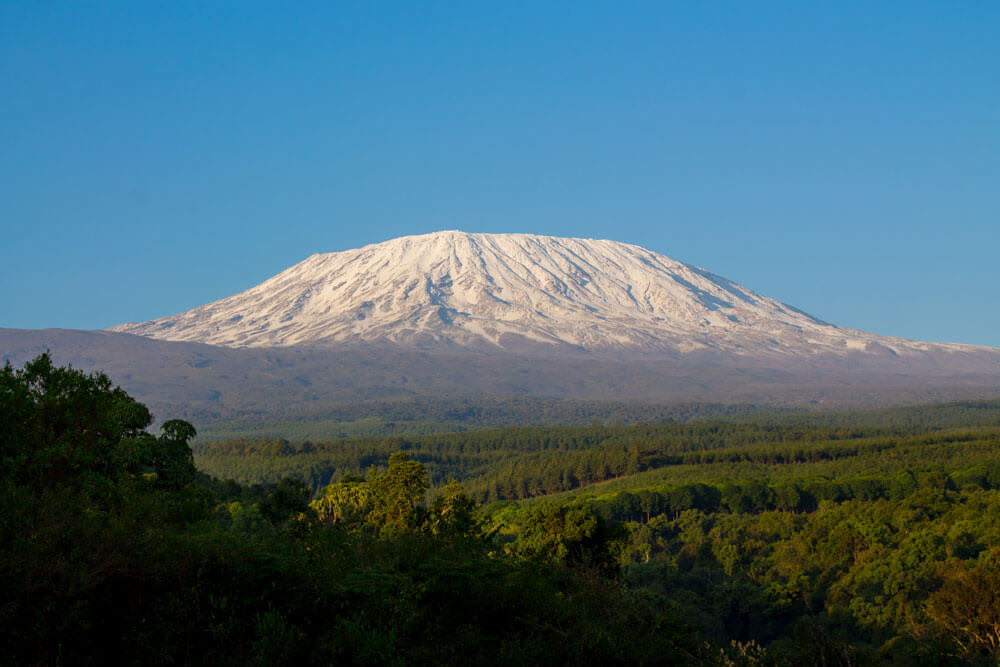United Republic of Tanzania

Capital city: Dodoma
Gained Independence: 1961 (Tanganyika gained independence from Great Britain, and combined with Zanzibar in 1964 to form the Tanzania now)
Joined Commonwealth: 9 December 1961
United Nations HDI Ranking (2019): 0.529
Official Languages: Swahili, English
Timezone: GMT +3 hr
Currency: Tanzanian shilling (TZS)
Doing Business Rankings: 141 (2020)
Population: 63,852,892 (2022)
Legal system: Common law
Main industries: Mining, electricity, natural gas
Principal exports: Gold, coffee, cashew nuts and cotton
The United Republic of Tanzania, the most populous country in East Africa, sits directly south of the Equator and shares its borders with Uganda, Rwanda and Burundi to the northwest, Kenya to the northeast, Mozambique to the southeast, Malawi directly south and Zambia to the southwest. It is encompassed by Lake Victoria, Lake Nyasa, Lake Tanganyika and the Indian Ocean. Tanzania’s 947,300 sq km territory holds an array of diverse landscapes. Northwestern Tanzania is home to massive mountain landforms including Mount Kilimanjaro, a popular attraction for hikers and the highest dormant volcano in Africa. Contrarily, the lowest point in Africa is at the floor of Lake Tanganyika, the west-most region of Tanzania. Towards the center is where the Serengeti National Park and the Ngorongoro Conservation Area are situated in, both of which are UNESCO World Heritage Sites and are the best safari holiday destinations in Africa. Other than Tanzania’s geological wonders, archaeological sites and historical records certifies that it is one of the origins of humanity; its rich culture and diverse ethnicity have lasted until this day, spreading their indigenous art and wisdom through agricultural activities, fishing, mining and tourism.

Demographics
Tanzania’s population, as at 2022, is estimated to be 61,498,438, the largest in East Africa. The high total fertility rate of 4.8 children per woman has contributed to its population growth rate of 2.78%. The country’s high dependency ratio of 85.9 is mainly attributable to its youthful population with about 62% of the population being under 25, and 42% being under the age of 14. About 37% of Tanzania’s population lives in urban residences and the nation has amongst the fastest rates of urbanisation, currently at a rate of 4.89%.
Ethnic compositions in the Mainland and Zanzibar differ. 99% of Tanzanians in the Mainland are native Africans, most of which are of Bantu descent consisting of more than 120 tribes. The population in Zanzibar consists of Arabs, Africans, and mixed Afro-Arabs. Overall, the main religion practiced in Tanzania is Christianity (63.1%), followed by Islam (34.1%). Almost the entire Zanzibar population are Muslims. Folk religion followers, Buddhists, Hindus, Jews comprise 1% of the population respectively.
Among the hundreds of languages used in Tanzania, Swahili is the national language while English is the official language for administration, foreign trade and higher education. Other languages used include Arabic, Kiswahili and some 100 local dialects.
History
Tanzania is the birth grounds of human ancestry, dating back to the 1st millennium BCE. Its modern history started with the Portuguese’ exploration and occupation of the island of Zanzibar in the 15th and 16th centuries respectively. Their occupation, however, did not last long as Omani Arabs ousted them in 1699. During the 19th century, the Germans began to acquire territory on mainland Tanzania, and formed a colony called the German East Africa in 1897. The German colonisation was replaced by the British following Germany’s defeat in the First World War when Britain received a mandate from the League of Nations over Tanganyika in 1919, today’s mainland Tanzania. Following public campaigns for independence and majority rule, Tanganyika became independent in 1961 and a republic one year later. Subsequently, Zanzibar achieved independence in 1963. In 1964, Tanganyika and Zanzibar merged to become the United Republic of Tanzania.
Tanzania’s then president, Nyerere established diplomatic relations with Britain in the 1960s and subsequently with China in the 1970s, who largely contributed to financing the construction of a railway link between Dar es Salaam and Zambia. After Nyerere’s socialism policy was proved to be a failure, Ali Hassan Mwinyi took over as president in 1985 and strived to repair Tanzania’s economy by combating corruption and encouraging foreign investment. Thereafter, the Constitution of Tanzania was amended in 1992 to allow multiple political parties. Tanzania’s first multi-party elections was held in 1995 and concluded with the win of the Chama Cha Mapinduzi party, which was represented by every president up to date.
Key Dates
1498 The Portuguese explorer Vasco da Gama explores Tanzania
1506 The Portuguese occupied Zanzibar.
1884 Germans began seizing mainland Tanzanian territory.
1919 League of Nations gives Britain a mandate over Tanganyika.
1961 Tanganyika gains independence on 9th December and joins the British Commonwealth.
1963 Zanzibar becomes independent.
1964 The United Republic of Tanzania is established with the union of Tanganyika and Zanzibar on 26th April.
1967 President Nyerere codifies socialism in the Arusha Declaration, nationalising banks and important commercial companies.
1985 President Nyerere retires from the Presidential position and is replaced by Ali Hassan Mwinyi.
1992 The Constitution is amended to allow multiple political parties.
1995 Tanzania holds its first multi-party elections and Bejamin Mkapa from the Chama Cha Mapinduzi party is elected as President of Tanzania.
Legal System and Government
The Tanzanian government is a presidential republic based on multiparty parliamentary democracy following the amendment to the Constitution. The president, representing a registered political party, is elected by direct popular vote to serve a five-year term and a maximum of two terms. The president appoints a prime minister to perform the role of government leader in the National Assembly, which is the unicameral legislature. Most of the members of the Assembly are directly elected, while some are indirectly elected and a minority are appointed. To promote gender equality in political participation and representation, 30% of the seats in the Assembly are reserved for women. This is one of the reasons why the proportion of seats held by women in national parliament in Tanzania, being 36.72%, is higher than the world’s average of 25.58% in 2020. In 2021, Ms. Samia Suluhu Hassan became the first female president of Tanzania. The National Assembly together with the President forms the Parliament of Tanzania, which performs the legislative functions and scrutinizes governmental activities.
As a British colony during the 20th century, Tanzania inherited and adopted the English common law system with the exception of modifications, such as the power of judicial review limited to issues of interpretation only. Tanzania’s sources of law are as follows: the 1977 Constitution, the Statutes or Acts of Parliament, case law, Received Laws, and the Customary and Islamic law. Members of the judiciary are appointed by the President upon consultations from the Chief Justice. As stipulated in the Constitution, Tanzanian judges and magistrates are independent of the government and are only required to observe the Constitution and the law.
Economy
The economy in Tanzania has experienced rapid growth in recent years and is one of the fastest-growing economies in the world. Between 2010 and 2019, Tanzania’s GDP annual growth was 6%-7% on average. On 1 July 2020, following Tanzania’s increase in GNI per capita from $1,020 in 2018 to $1,080 in 2019, Tanzania’s status was upgraded from being low income to lower-middle income as its 2019 GNI per capita surpassed the threshold of $1,036 for lower-middle income status.
The agricultural sector is the foundation of the economy in Tanzania, accounting for around 30% of its GDP, employing almost three-quarters of its productive workforce and occupying 43.7% of Tanzanian territory. Apart from being crucial to Tanzanians in terms of employment opportunities, local agriculture is also key to Tanzanians as their major food source. As the geography and climate of Tanzania are diverse, Tanzanian farmers are able to grow a variety of crops, for instance food and cash crops, fruits, vegetables and spices. Maize, wheat, rice and sugar are amongst the most widely grown crops. They also raise cattle, goats, sheep, pigs and chicken. The agricultural sector is also looking to see optimistic growth with the flagship project, Southern Agricultural Grown Corridor of Tanzania (SAGCOT) as a source of foreign financing to boost crop production levels. The country strategic opportunities programme by the International Fund for Agricultural Development (IFAD), also plays a part in improving farmers’ access to markets and promoting agricultural investments both publicly and privately.
Tanzania’s wealth of natural resources extends to minerals and metals. This contributes to the development of its mining sector, which is one of its leading industries. Compared to a 10% growth in the first quarter of 2019, there is an estimated growth of 15.3% in Tanzania’s mining industry during the same quarter of 2020. The mineral revenue collection increased from US$84.5 million in 2015/16 to US$202.7 million from July 2019 to April 2020. Common minerals extracted include metallic minerals such as gold, iron ore and copper. In particular, Tanzania is the 4th largest gold producer in Africa, and its gold exports amounted to US$3,025.4 million in the year ending March 2021. Tanzania is also known for its abundance of gemstones including diamond and ruby. In particular, tanzanite, one of the rarest colored-stones, is exclusive to the Mererani Hills in Northern Tanzania. Industrial minerals like limestone and soda ash are also found and mined in Tanzania.
Tourism is another industry that has made significant contributions to Tanzania’s economy. Tanzania generated US$2.6 billion of revenue from the tourism industry in 2019, marking an 8.3% growth from the US$2.4 billion in 2018. The number of arrivals of Tanzania doubled within 10 years, increasing from 714,000 in 2009 to 1,527,000 in 2019. Tanzania’s strength in tourism is also evidenced by the 48.6% increase in tourist arrivals in 2021, a strong bounce back from the Covid-19 travel restrictions imposed in 2020. Tourists are attracted by the wildlife and beaches of Tanzania, as they are considered few of the finest in the world. Constituting more than 25% of Tanzania’s total area, the wildlife national parks and protected areas in Tanzania include national parks, game reserves, forest reserves, conservation areas, and marine parks and reserves. Mount Kilimanjaro, the highest free-standing mountain in the world, is also popular international tourist attraction which generates an estimated US$50 million in revenue annually. Recently, the Tanzania Tourist Board is actively supporting over 41 Cultural Tourism Enterprises in promoting Cultural Tourism where tourists can experience the way of life of indigenous people, learn traditional handicrafts, taste local cuisines and much more.

Trade
The GDP of Tanzania reached US$ 67.8 billion in 2021. For the same year, total export of goods and services added up to around US$ 9.7 billion, while the total import of goods and services reached around US$11.5 billion. Top exports in 2021 were natural or cultured pearls, precious/ semi-precious stones, precious metals and articles thereof (46.5%), cereals (6.3%), edible vegetables, roots and tubers (4.7%) and oil seeds and oleaginous fruits, grains, straw and fodder (4.2%). Main export destinations for the year were the UAE (16.5%), India (15.8%), South Africa (14.3%), and Switzerland (8.2%). The main products imported in Tanzania in 2021 were mineral fuels, mineral oils and products of their distillation (20.9%), machinery, mechanical appliances, nuclear reactors, boilers and parts thereof (10.9%), vehicles other than tramway/railway rolling stock and parts thereof (8.8%) and iron and steel (6.5%). These imports were mainly procured from China (24.8%), the UAE (12.5%), India (11.1%) and Saudi Arabia (6.2%).
As a member of the East African Community (EAC) and the Common Market for Easter and Southern Africa (COMESA), Tanzania enjoys free trade opportunities with multiple countries including members of EAC. Through the African Growth and Opportunity Act (AGOA)[1] of the US and the Everything But Arms (EBA) programme of the EU, Tanzania can export goods into US and EU markets duty-free and quota-free.
Investment Opportunities
The Tanzania Investment Centre (TIC) cooperates with entities to promote quality investments in Tanzania. With the support of TIB Development Bank Limited, many investment projects are seeking joint venture partnership.
Regarding investment opportunities in the agricultural sector, fruit and vegetable processing has great potential because only 4% of Tanzania’s annual fruit and vegetable production of 2.75 million tons is processed. For instance, the rapid developing Avocado sub-sector in Tanzania offers a wide variety of opportunities for interested investors. In addition, Tanzania’s large livestock population allows the leather sector as well as the meat and dairy sector to have significant investment potential.
Investment opportunities in Tanzania’s mining industry include the operation of gold refinery activities, gemstone cutting and polishing, rock and mineral carvings, mineral processing and mineral exploration. Reliable energy and transport alternatives are also much sought-after by the mining sector.
Tanzania’s Wildlife Management Areas (WMA), which are areas exclusive for nurturing wildlife habitats, offers meaningful and profitable investment opportunities. Since WMAs are completely managed by local communities, investors’ support directly go to the social-economic wellbeing of surrounding communities. This also leads investors to explore investments in the tourism sectors such as tour operators, travel agencies, hotel management and construction, infrastructure ventures and training institutions to support the large influx tourists given Tanzania’s strong recovery from the pandemic.